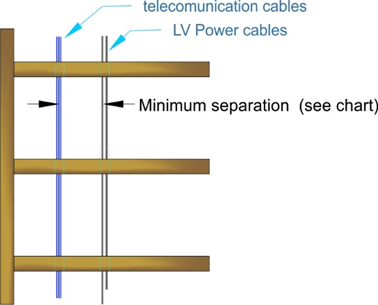What do I need to know about installing data and telecommunication cables?
Guidance to assist the electrical worker to ensure data and communication networks are safe, compliant and to mitigate any hazardous or detrimental effects from general electrical wiring work.
- Safe Work
Trend for integration of services
There are increasing levels of integration between the various services and applications in homes and other buildings These include telephone, data, broadcast TV, audio, video, gaming, security and building control services that are interlinked through generic or structured cabling system utilizing data cable such as Cat 5 or Cat 6 unshielded twisted pair (UTP) and coaxial cables operating at very low voltages typically well below extra low voltage (ELV).
This trend also means that electrical workers are becoming increasingly involved with the installation of these extra-low voltage communication and data systems alongside the general electrical power and lighting wiring.
Safety risks
Substandard installation practices in these types of installations have potential safety risks associated with hazardous higher voltages from general electrical wiring (230 or 400 volts, low voltage) (LV) entering ELV communication /data network installation as well as possible detrimental effects on functionality of the communication network through electrical interference and signal loss caused by electrical induction.
For these reasons it is important that persons carrying out this work are competent and familiar with the requirements of AS/NZS 3000 and the NZ Telecommunications Forum Premises Wiring Code of Practice.
Compliance and best practice
AS/NZS 3000 (the standard) has a number of requirements related to the segregation of general electrical services from telecommunications, extra low voltage and other non-electrical services. The clauses containing this information can be searched and found in the standard through the index or search function of the online version of the standard. (Search telecommunications) This standard is freely available to licenced electrical workers through the ERWB website.
The TFC Premises Wiring Code of Practice(external link) (TFC code ) is referenced by AS/NZS 3000 and provides the cable installer with a set of best industry practice guidelines to assist them to plan, install and maintain these types of communication networks to ensure they are electrically safe and provide long‐term performance and reliability.
Here are examples of substandard / non-compliant installation practices, where insufficient separation between data and other electrical cables has created examples of the potential risks highlighted above.

Quick guide to segregation of services requirements contained in AS/NZS 3000 and the TCF Code
(Please note these are not comprehensive and the installer must be familiar with the specified standard and code)

| Services | Distances | Minimum requirements and good work practices |
|---|---|---|
|
LV electrical cables and communication cables |
Minimum 50mm |
To avoid the risk of electrical hazard and noise caused by induction, Telecommunications cables must be installed with a permanent separation of at least 50mm from mains power cables in all locations, except where the cables are separated by a rigid barrier, an AS/NZ3000 requirement. Either side of the stud is a good method of achieving this separation. To minimise the risk of noise by induction, telecommunications cable should not be run closely spaced and parallel to wiring of other services. Where it is not practicable to completely avoid such parallel runs, any length where spacing is close to the minimum of 50mm, should not exceed 3m. |
|
LV electrical cables and communication cables |
Recommended 300mm |
To minimise the risk of electrical interference from mains and switching transients or interference generated by appliances, the recommended spacing is at least 300mm wherever it is practicable to do so. |
|
LV electrical fittings and communication outlets |
Minimum 200mm |
Communication outlets associated hardware should not be fitted closer than a horizontal distance of 200mm from any fitting on which mains voltage cables are terminated, unless separated by a rigidly fixed barrier Complying barriers include wall linings, full depth framing in walls and substantially enclosed mounting boxes. Electrical flush mounting brackets and open type flush boxes are NOT substantially enclosed in the above context. Without a barrier, the minimum 200mm horizontal separation applies to both sides of a wall unless the wall cavity exceeds 200mm depth. |
|
LV Sockets switches faceplates and communication outlets |
Not permitted |
Under NO circumstances shall Low Voltage (LV e.g., 230 V) sockets, switches or modules be mounted on the same faceplate as components that operate at voltage levels at which telecommunications and data services operate. AS/NZS 3000 requires that all faceplates comply with AS/NZS 3112, clause 3.2 of which prohibits mixing of these voltage levels on the same faceplate. |
|
LV electrical cables in underground shared trench |
Minimum 50mm |
Telecommunications in white conduit, LV cable in orange conduit, 50 mm between conduits. |

